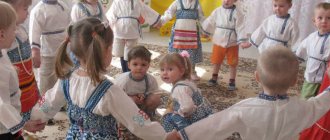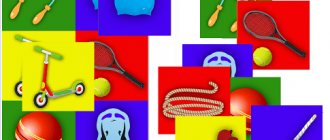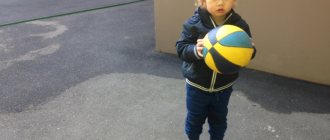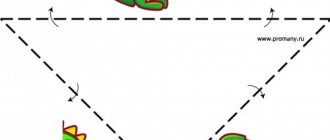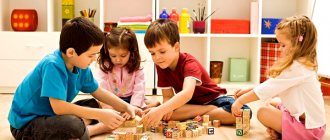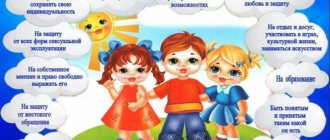Olga Ivanova
Card index of fun games for older children
Card index of games - fun for older children
Prepared by: teacher Ivanova O.V.
Fun games No. 1
«Potato»
Goal: To encourage emotional responsiveness, develop communication skills with adults and peers.
Move: All players stand in a circle and pass the ball to each other, hitting it. If someone does not hit the ball, he squats in the center of the circle and the game continues. Any player can help out the “offender” if he wishes. To do this, when hitting the ball, he tries to hit those sitting in (the one who was touched by the ball)
takes part in the game again.
Those sitting inside the circle try to catch the ball flying towards them.
If someone succeeds, then all those “punished” return to the game, and the player who threw the ball takes their place. Fun games No. 2
"Paints"
Goal: To encourage emotional responsiveness, develop communication skills with adults and peers.
Move: One of the players is the “buyer”, the other is the “seller”, all the rest are the “paints”. Each “paint” wished for its own color and told it to the “seller”. “Paints and the seller” sit on the bench and the buyer immediately comes: “Knock-knock!” “Who’s there?” asks the seller. "I, the buyer." “Why did you come?” “For paint”, “For which one?” A specific paint color is called; if it is not there, the “seller” replies: “There is no such thing. Jump along the path on one leg!” The “buyer” makes a circle on one leg and returns for more paint. If there is paint, the “seller” says: “There is one. Pay... rubles." The “buyer” “pays” - by clapping his palm the required number of times, the “paint” jumps up and runs away. The “buyer” tries to catch the paint ; if it succeeds, the “paint” becomes the “buyer”.
Fun games No. 3
"The quieter you go, the further you'll get "
Goal: To encourage emotional responsiveness, develop communication skills with adults and peers.
Progress: At a distance of 30 meters from each other, two lines are drawn - “ start ” and “finish”. The players stand at , the driver stands with his back to them at the finish line. He says the phrase: “The slower you go, the further you will go. One two Three!". During this time, players try to get as close to the finish line as possible. Having finished speaking, the “driver” quickly turns around and examines the participants in the game, who must freeze. The one who moves goes beyond the starting . the start line first wins . He becomes the driver.
Fun games No. 4
"Dodgeball"
Goal: To encourage emotional responsiveness, develop communication skills with adults and peers.
Move: All players, except two, stood in a line in the center of the court. They, throwing the ball to each other, had to knock out all the players. The one who was touched by the flying ball comes out! from the game. When all players were eliminated, the game started over.
Fun games No. 5
"Ring"
Goal: To encourage emotional responsiveness, develop communication skills with adults and peers.
Procedure: Play while sitting on a bench. Everyone folds their palms in a boat, and the leader, who has a small object in his palms (a ring, a pebble), runs his hands between the palms of each player, quietly puts a ring in someone. Stepping aside, he says: “Ring, ring, go out onto the porch! "The player with the "ring" must quickly stand up, and the other participants must hold him. If it was successful, he became the leader.
Fun games No. 6
"Magic Palms"
Task: exercise to develop a sense of one’s own movement.
Progress of the game:
“Water, water,
Wash my face (children perform washing movements)
To make the eyes sparkle (children show round eyes)
To make the cheeks red (children hold their cheeks)
So that the mouth laughs (children smile)
And the tooth bit him.” (children click their teeth)
Fun games No. 9
“Our Masha is small.”
Purpose: exercise to develop a sense of self-movement
“Fun toys as the basis of children’s play” material (junior group) on the topic
“Toys are fun as the basis of children’s play”
Fun toys can evoke an emotional response in a child, stimulate his development, intensify play, and promote the musical development of children. Thus, the problem of using toys to solve the problems of development of preschool children is currently relevant.
Purpose of the work: to expand the understanding of the richness of the world of toys and fun; show how toys influence the development of children of different age groups; promote the development of the emotional sphere of motor activity, expand the cognitive abilities of children.
The objectives of fun toys: To interest and captivate children with the beauty and unusualness of fun toys. Arouse interest in the toys of parents and grandparents. Expand knowledge about the history of Russian toys. To instill in children, through family and friends, kindness, responsiveness, love of traditions, and respect for toys.
Types of fun toys: “twitchers”; balls with elastic bands; gymnasts spinning on horizontal bars; jumping birds, frogs, butting goats, etc.; Folk toys made of wood and papier-mâché with ingenious devices that produce an amusing effect are widely known (pecking birds, carousels, moving wooden toys; amusement toys also include sets of tricks and surprise toys.
Their meaning: “fun toys”, as defined by E. A. Flerina, are used to entertain children; arouses curiosity, joy and positive emotions in children; maintain a cheerful mood, develop a sense of humor and curiosity; encourage children to study their structure, principle of operation, and also create a zone of shared experiences with adults. especially needed in children's groups of different ages, where older children can please the younger ones with a fun joint game with a funny toy; allow the teacher to establish contact with children, relieve tension, distract children from unwanted behavior, and create a desire to participate in joint play.
Basic requirements for the manufacture of fun toys
1) creation of a wide range for each age group of children;
2) a fun toy must be durable.
The influence of toys and fun on children under one year old: The child’s objective actions are related to his psychophysical development. As soon as the child begins to sit, he loves to manipulate the toy, trying, in imitation of an adult, to knock on a funny apple or pegs with a hammer. Children from five to nine months are shown toys that stimulate crawling, including large, bright tumblers. And these are one of the first toys that we classify directly as fun toys. A child enjoys playing with a tumbler doll at a very early age. The baby happily examines the tumbler, rocks it, pushes it, watches its movements and listens to sounds while playing. As soon as he drops this toy, it immediately takes a standing position on its own.
The tumbler is considered a traditional toy for children. It combines a rattle and a stabilizing device, attracts with its bright color, shape, comfortable and safe for the baby. According to the figurative solution, tumblers are, first of all, dolls, bears, dogs, birds, both of a design familiar to many generations and of an unusual design. There are also construction tumblers with parts of varying degrees of hardness and different sizes.
The influence of toys - fun on children from 1 to 2 years old.
After the first year of life, the child is also shown twitch toys, medium-sized or large-sized tops with a sound effect, and squeaker toys (when touched, a sound or melody is heard). For fun and development, there are educational games for children from 1 to 2 years old, and toy books have been invented (with a sounding device, for playing in water, etc.). Toy books with a sounding device are made of fabric, thick cardboard.
The influence of toys - fun on children 2-3 years old.
Fun toys for children under 3 years of age are intended to be played with an adult, under the supervision of an adult. But a one and a half year old child can already launch a small top. The toy develops fine motor skills well. A thin, comfortable handle, light weight, and the child enjoys learning to correctly calculate the strength and precision of the movements of the fingers and hand. A funny-sounding toy - a metal organ with a surprise. The barrel organ makes a pleasant melodic sound. Playing with a barrel organ promotes the aesthetic development of a child and improves the emotional background. First, the child is introduced to the inhabitant of the barrel organ, music is played, and then a surprise moment can be arranged.
The influence of toys - fun on children 3-4 years old.
For children 3-4 years old, figurines of animals and birds with a winding mechanism are especially interesting. Wind-up toys can diversify the actions of human and animal figures. The figures can be united by a common plot and represent toys that imitate actions (pecking, jumping, dancing, playing music) with various effects (musical, noise, color, light, etc.). Children independently play with pleasure with funny ducklings, pecking birds, and soft voiced animals that imitate the action. Bright, colorful bunnies, squirrels, bears, dogs, and cockerels immediately attract the attention of children. They find and recognize in these “fun” images of familiar animals and birds, and the game develops - children build houses for the animals, give them rides in cars, and invite them over for lunch.
The influence of toys - fun on children 4-5 years old.
At the age of 4-5 years, the nature of games for children changes, so folk toys made of wood (“Blacksmiths”, “Chickens on a Circle”, “Magpie and Squirrel”, “Gymnast Bear”, etc.) appear among the fun toys for them. funny figures with mechanisms (moving on an inclined board “Ducklings”, “Bull”, “Vanka-Vstanka”, etc.), bibabo dolls, voiced tops and tumblers, turntables.
The influence of toys - fun on children 5-6 years old.
Children 5-6 years old are interested in mechanical and electrified toys, as well as hydraulic, pneumatic, and articulated ones. The electrified railway is offered as a fun toy to be shown to children aged 5-7 years. Fun toys for children 6 years old are small tops made of different materials, homemade tops, figurines of animals and birds with funny movements, with music, singing or onomatopoeia, voiced (for playing “concerts”, etc.), funny caricatured animal figurines (with magnet).
Methods of practicing with toys and fun.
It is recommended to play fun games with preschool children every day in the morning or evening, when the teacher and children have a “free minute.” The duration of the fun games cannot be determined exactly. You need to play with children until they really have fun, rejoice and have fun. This time ranges from 1 to 5 minutes. It is not advisable to increase the duration of fun games, because overexcitation and overwork have a negative impact on children's health.
When conducting fun games with children, a mandatory condition is to provide them with free use of the toy with which the children acted under the guidance of an adult. It is advisable to accompany all the teacher’s actions with words: • first with direct instructions, • then with verbal instructions, of course, while focusing on the child’s experience. The content of fun games (shows) should be more “intricate” than children’s actions in independent play, but taken from real reality, close to the child. What is required from the baby? Carefully monitor the teacher’s actions and listen to his explanations. And this is only possible if he is interested. When playing entertainment with children, you should keep them all in sight, guide the children’s activities, immediately respond to emerging conflicts, and suggest the next course of action. The special task of the teacher is to arouse a keen interest in the game in children, to please them, to make them laugh, and to create a good mood.
Results of using fun games in educational activities:
• create a good, joyful mood in children;
• contribute to the establishment of positive relationships between the teacher and children;
• develop children's speech;
• develop fine motor skills of the hands;
• introduce the child to fun toys;
• enrich children's emotional experiences;
• contribute to the disclosure of the creative potential of the teacher.
Thus, fun toys (swinging bull, pecking chickens, blacksmiths, sawy bears) are intended to amuse and entertain the child. They evoke curiosity, joy, and positive emotions in children. Fun toys maintain a cheerful mood, develop a sense of humor and curiosity. They encourage children to study their structure, principle of operation, and also create a zone of shared experiences with adults. Fun toys help the teacher organize collective entertainment. This type includes surprise toys with a variety of movements, sound, light and other effects. The toys are simple, dynamic, with gentle humor. They show the wisdom, ingenuity, ingenuity of folk craftsmen, their love for children, and their desire to amuse them.
Progress of the game:
Our Masha is small, (children bend down to the floor and show little Masha)
She is wearing a scarlet fur coat (children show the fur coat)
Beaver edge (children spread their hands and show the edge)
Masha black-browed (children point to eyebrows)
Fun games No. 10
“Cucumber, cucumber.”
Purpose: exercise to develop a sense of self-movement
Progress of the game: At one end of the playground there is a teacher (trap, at the other there are children. They approach the trap by jumping on two legs. The teacher says:
Cucumber, cucumber,
Don't go to that end
There's a mouse living there
He'll bite your tail off.
At the last words, the children run away, and the teacher catches up with them.
Fun games No. 11
Purpose: exercise to develop a sense of self-movement
Games and fun in kindergarten for children 3-5 years old
Games and fun for children of primary preschool age, preschool educational institution
Author: Dvoretskaya Tatyana Nikolaevna GBOU School No. 1499 Preschool No. 7 Educator Description: Games are intended for children of primary preschool age, can be useful material for teachers of preschool organizations and parents. Purpose of the work: Author's games for children are aimed at developing the socialization of children, arousing interest and desire to play joint games
Goal: to develop in preschool children the interest and need to play with peers Objectives: 1. to arouse interest in group games in preschool children 2. to form in children a positive attitude and desire to play joint games 3. to cultivate a friendly attitude when playing with peers 4. to develop the cognitive and speech activity of children through play. Preface In modern pedagogical theory, play is considered as the leading activity of a preschool child.
The leading position of the game is determined not by the amount of time that the child devotes to it, but by the fact that it satisfies his basic needs. In the depths of the game, other types of activities arise and develop. Play contributes to mental development to the greatest extent. Dear teachers, I present to your attention my original games for children. I hope the material will be useful and in demand in your work. Game No. 1: “Top-top-top” for children 3-5 years old
This game can be played with children of primary preschool age, both in a group and on the street.
Rules of the game: - Children stand next to the teacher and form a small circle. — The words for the game are pronounced in chorus, rhythmically, with the addition of movements according to the meaning of the text (when learning the game, the teacher will need to show you)
Words for the game: One - Two! Three four! (children take 4 steps back)
We will make a wider circle
(form a large circle without holding hands)
We will smile at a friend nearby
(turn and smile)
We will hold hands tightly.
(Hold hands)
Step by step we will go, stretch our legs.
Top - top - top! The guys are coming Top - Top - Top! They are going somewhere. (rhythmic steps are taken to the right)
Stop at the gate.
(stopped and stood still)
So there will be a turn.
(turn to the left)
The children turned around together!
You need to keep moving. Step by step we will go, stretch our legs. Top - top - top! The guys are coming Top - Top - Top! They are going somewhere. (rhythmic steps are taken to the left)
Past the river and lakes.
Past the forest, past the mountains. Everyone is walking, their feet are moving. Stop - stop - stop. End of the road. (stopped and stood still)
We have arrived!
Meet us. (turn your face in a circle, stretch 2 arms forward)
And clap 5 times.
(Clap your hands)
Game No. 2: “Snake” for children 3-5 years old
The game is played outside while walking.
Attributes for the game: - A snake drawn with yellow chalk (paint) on the asphalt and 5-6 multi-colored circles (balls) Rules of the game: - Children line up one after another - They say in chorus the call for the game Call for the game: The snake played with balls This is how it played that I'm tired. The poor thing lay down in the shade and was too lazy to crawl any further.
Words for the game (pronounced by the teacher) One, two, three, four, five I invite you to play. We will go with you along the path along the curve. (running along the snake one after another)
Don’t be timid, my friend.
You run forward quickly. Hide your hands behind your back. Jump on the ball with your feet. (jumping on 2 legs)
One!
Two! Three! Four! Five! We know how to win. Hurray for the champions! The game continues. (Children who have run all the way return to the end of the snake’s tail and, if desired, go through it again)
The game can continue until the children’s interest remains.
Recommendations: The second player starts moving only after the first player reaches the middle of the snake.
Game No. 3: “Cats and Mouse” for children 3-5 years old
This game can be played with children of primary preschool age, both in a group and on the street.
Attribute for the game: - Cat mask Characters: Cat - child Mice - children
Rules of the game: - Child - a cat sits on a chair (in the bushes) - Children - mice are running away from the cat Words for the game: The mice decided to go for a walk. Fidgety - naughty girls. (Children-mice go out for a walk on tiptoe)
Here they are running along the grass Zipper – Zipper – Zipper
(running into the loose grass)
They jumped over the ditch
(jumping on 2 legs)
Jump – Jump – Jump Suddenly a terrible sound was heard
(The teacher knocks on the chair with a stick, on which the cat sits)
And the heart KNOCK - KNOCK - KNOCK The cat hid in the bushes And opened its toothy mouth.
The mice will be in trouble for you. Run away in all directions... (The cat begins to catch the mice, trying to hit them on the shoulder. The mice run away)
Parting words from the author:
There are a lot of games, entertainment and activities in our world. You should never be bored in the company of friends!
We recommend watching:
Water games for the second younger group. Card index Fun game “Roosters” for the younger group Nursery rhyme “Chicks” for games with children of the younger group Musical games for the younger group of kindergarten
Similar articles:
Coloring pages for children “Pets”
What are educational games for preschoolers
Games to develop attention for children 3-4 years old in kindergarten in a group
Didactic games in the younger group. Card index
Playing with sand in the younger group
Types of outdoor games for older kindergarten groups
There are five main types of outdoor activities for preschoolers:
- story games. Each child plays a certain role and follows the rules, for example, “Cossacks-robbers”;
- exercises without a plot. These are, for example, throwing the ball as far as possible, “Catch-up”;
- folk entertainment such as “Blind Man’s Bluff” or “Hide and Seek”;
- relay races and competitions;
- children's sports competitions - football, running, skiing.
Drawing lesson on the theme “Maslenitsa” in the 2nd junior group of a preschool educational institution
Long-term plan for entertainment and leisure activities in the senior group
Long-term plan for entertainment and leisure activities in the senior group
Organizational and pedagogical work
September
1. Entertainment “September 1st – Day of Knowledge.”
Target:
show children the social significance of the holiday - Knowledge Day; bring joy, create a cheerful festive mood; develop independence and initiative, artistic and aesthetic taste; cultivate neatness and friendliness.
2. Theatrical entertainment “Journey to the country of Igralia.”
Target:
create a joyful mood in children; consolidate knowledge of fairy tales, active and round dance games.
3. Entertainment “Young pedestrians”
.
Target:
consolidate children's knowledge of the rules of safe behavior on the road; promote the development of attention and thinking; cultivate a culture of behavior on the street, friendly relations with each other.
4. Physical education “Fun competitions”.
Goal: to create a joyful mood in children; develop dexterity, speed of reaction, coordination of movements; cultivate endurance, courage, activity.
5. Entertainment “Festival of Soap Bubbles”.
Target:
develop communication skills in children, activate creative abilities.
October
1. Sports entertainment “For health in kindergarten.”
Target:
promote the comprehensive development of motor skills, develop competitive skills, and cultivate a caring attitude towards one’s health; develop positive emotions, feelings of mutual assistance, friendship, empathy, promote the development of play motor activity.
2. Entertainment “Learning to be artists.”
Target:
arouse interest in theatrical and gaming activities, continue to teach children to transform themselves in games through the development of sign language, facial expressions, and pantomimes. Develop teamwork skills and cultivate friendly relationships.
3. Entertainment “Riddles from the vegetable patch.”
Target:
strengthen children's understanding of vegetables; expand your vocabulary on the topic; consolidate singing and motor skills.
4. Leisure “Walk in the autumn forest.”
Target:
create a joyful mood in children; evoke emotional responsiveness, promote the development of interest in the world around us, and form ideas about correct behavior in nature.
5. Autumn Festival.
November
1. Musical entertainment “Our fun concert.”
Target:
create a joyful mood in children while singing, moving and playing to music.
2. Entertainment “Mom is my sunshine.”
Target:
evoke an emotional response in children, cultivate love and respect for their mother.
3. The game is a dramatization of the fairy tale “Little Red Riding Hood” by C. Perrault.
Target:
develop children’s speech and creativity, the ability to carefully follow the course of a fairy tale and the actions of fairy-tale characters; improve communication and motor activity.
4. Physical education “Sea voyage”.
Target
: continue to build children’s knowledge about a healthy lifestyle; teach to perform actions when given a signal; develop physical qualities: agility, speed, endurance, bring joy and pleasure from joint activities.
5. Entertainment “Journey to the Island of Friendship.”
Target:
to develop in children the need for friendly communication with each other; teach to observe basic rules of politeness, communication culture, and develop communication skills.
December
1. Sports leisure “Adventures in the enchanted forest”.
Target:
to introduce children to a healthy lifestyle, develop interest in physical education, and promote increased physical activity.
2. Showing the Russian folk tale “The Fox, the Hare and the Rooster.”
Target
: encourage children to actively participate in theatrical play, develop speech, creativity, communication skills, and cultivate independence in play.
3. Entertainment “Button Festival”.
Target:
introduce the history of the button,
create a joyful and cheerful mood in children.
4. Musical and theatrical entertainment “Winter Patterns”.
Target:
make children want to participate in games, songs, dances, round dances; cultivate a kind attitude towards each other, the ability to negotiate and listen.
5. New Year's party.
January
1. Physical education “Winter Olympics”.
Target
: develop interest in winter sports through relay races and competitions; increase the level of physical activity; develop the ability to act in a team and pass the baton.
2. Musical entertainment “Merry Orchestra”.
Target:
consolidate children's knowledge about musical instruments; develop musical memory, attention, sense of rhythm; develop interest and love for music through games.
3. Game - quiz “We love fairy tales.”
Target:
to evoke joy from meeting your favorite fairy tale characters, to form a stock of literary artistic impressions, to cultivate an interest in reading, a love of oral folk art, a desire to take part in team competitive games,
4. Game - fun "Blind Man's Bluff with a Bell."
Target:
create a joyful mood in children, make them want to participate in the game with everyone else.
February
1. Sports festival “We will serve in the army, we will love our Motherland.”
Target:
promote the consolidation of skills in performing basic types of movements; develop physical, volitional qualities, determination; cultivate love for the Motherland; a feeling of respect for the Russian army.
2. Theatrical game “Hare - Brag.”
Target:
teach children to actively participate in joint games, to clearly carry out the actions of the role they have taken on; cultivate friendship, the ability to act in concert.
3. Entertainment “Fire is a man’s friend, just don’t touch it in vain!”
Target:
consolidate knowledge about fire safety rules and rules of conduct in case of fire; cultivate respect for the work of firefighters.
4. Entertainment “Musical Kaleidoscope”.
Target:
create a joyful mood in children when singing, moving and playing to music; make you want to participate in games with everyone.
March
1. Entertainment for March 8th.
2. Quiz “We love cartoons!”
Target
: consolidate and generalize children’s knowledge about cartoons; promote the development of thinking, memory and imagination.
3. Physical education “Chest of folk games.”
Target:
create a positive emotional, cheerful mood in children; develop motor skills, cultivate interest in folk games.
4. Entertainment “Mysteries of Spring”.
Target:
create a joyful mood in children, develop cognitive interest in the natural world around them, and cultivate a sense of respect for comrades and play partners.
April
1. Sports entertainment “Health Cosmodrome”.
Target:
consolidate children's knowledge about space; develop the ability to use basic types of movements in game situations; to cultivate curiosity, courage, dexterity, and endurance in children.
2. Musical entertainment “We love to sing, play and dance.”
Target:
create a joyful mood in children while singing, moving and playing to music.
3. “Visiting Grandfather Korney” - a literary quiz based on the works of K.I.
Chukovsky.
Target:
consolidate children's knowledge about the read works of K. I. Chukovsky, enrich and activate vocabulary; develop children's thinking and creative abilities; cultivate kindness and respect for each other.
4. Entertainment “Journey to the land of safe roads.”
Target:
develop children's skills for safe behavior on the roads; develop the ability to navigate in various environments, educate competent pedestrians.
5. Spring fun.
May
1. Musical and literary composition for Victory Day “We remember, we are proud.”
Target:
to develop in preschoolers an interest in the historical past through military-patriotic poetry and music; to cultivate a respectful attitude towards war veterans and home front workers, a sense of pride in their homeland.
2. Entertainment “Our Tales” - dramatization games with bibabo dolls.
Target:
development of interest in theatrical activities, development of communication skills, imagination, creative abilities.
3. Ecological quiz “Along the forest path”.
Target:
consolidate children's knowledge about the rules of behavior in nature; cultivate a love for nature and respect for it.
4. Sports entertainment “Fun Starts”.
Target:
give children pleasure from joint physical activity in sports games, relay races, increase physical activity; develop spatial orientation; to cultivate the competitive spirit of preschoolers and mutual assistance.
5. Fun “It’s fun to walk together.”
Target:
develop communication skills and bring joy to children.
Stages of organizing classes
Preparation for the game should include familiarizing children with the topic, basic rules and the result of the activity.
Note! It is important to prepare in advance additional materials that may be required during the process (balls, balls, sticks, ribbons for blindfolding, etc.).
You can motivate children to play by telling them fairy tales, asking them to solve riddles, or watching pictures/short videos showing the game process.
According to the Federal State Educational Standard, the duration of outdoor games in the senior group should not exceed 20 minutes. You should make a plan in advance (three months in advance). An example of a children's activity plan for three winter months:
- December 15 – game “Snowballs”. The goal is to develop the eye, accuracy and strength. The lesson is conducted on a walk. A circle is drawn on a sheet of plywood, into which children must hit it with a snowball from a certain distance, having previously molded it.
- January 15 – game “Ball for the Driver”. Two lines are drawn. On one, the players stand in a column, on the other, on the contrary, there is a driver who throws the ball to the first participant. He catches him, throws him back and stands at the end of the group. The game continues until the last player throws the ball to the driver.
- February 15 – game “One, two, three...”. Children energetically walk around the hall in a chaotic manner. When the teacher calls one of the numbers (1, 2, 3), the kids should stand up individually, in pairs or in threes, respectively, as quickly as possible.
Note! Control of outdoor games is carried out by analyzing the active activities of preschoolers, recorded in special forms and report sheets.
Active activity in the hall
Card index
Examples of games that can be played outside.
| Name | Description |
| "Classics" | Held in summer. A classic field, familiar to everyone from childhood, is drawn with chalk on the asphalt. The teacher shows how it needs to be overcome. There are many options: on two legs, alternately, using a pebble, only back and forth, back and forth, etc. There is also “Hopscotch” in the shape of a square (3x3), the meaning of the game is similar. |
| "Blind Man's Bluff" | The presenter is blindfolded, twisted a little and scatter in different directions. His task is to find other players who can tell their location by clapping their hands. The first person the leader touches takes his place. |
| "Higher than your feet off the ground" | A game for walking in the summer months. The driver must catch the other players, following one rule - you cannot touch anyone standing on a hill. It is forbidden to stay in the “safe” zone for a long time, therefore, as soon as the driver leaves, you need to leave it and look for a new elevation. |
| "Hot potato" | Children stand in a circle and throw the ball to each other, catching it and immediately throwing it to the next one. Whoever doesn't catch the ball sits in a circle. To return to their position, the participant must catch the ball or at least touch it by jumping. |
| "Edible - inedible" | The teacher throws the ball and names any words. If the named object is edible, the child must catch it; if it is inedible, he must fight it off. In this way, the speed of reaction and thinking is trained. |
Children playing Hot Potato
Examples of games that are played in a kindergarten.
| Name | Description |
| "Builders" | Children are divided into two teams and go to different sides of the hall. When the music plays, the kids walk or run in a circle. As soon as it stops, the leader says: “We are building a column (line or circle).” The children's task is to build the named figure faster than the opposing team. For example, if you need to make a circle, you can quickly hold hands. |
| "Statue" | Players stand in a circle and throw a ball to each other. If someone didn’t catch it, then they stand on one leg; if they didn’t catch it the second time, then they stand on one knee, and the third time, they stand on two knees. If in one of these positions the child grabs the ball, then his misses are forgiven, and he rises again on two legs. |
| "Pass and stand up" | Suitable for traditional competitions between groups in the fall. Children are divided into two columns. When the whistle blows, the guys raise their hands up, and the first participant passes the ball over his head to the next. Once he has reached the end, the last player runs forward and becomes the first. The game continues until the first player is ahead again. |
| "Penguins" | A story-based game for relay races in winter. The child holds a small ball between his legs and jumps on two legs to the line (at a distance of 10-15 m) and back. Passes the ball to the next one and so on in turn. The winner is the team in which all players complete the “Penguin Path” faster. |
| "The Fisherman and the Fishes" | To play you will need one jump rope. The leader-fisherman (necessarily the teacher) carefully moves the rope around the floor. The fish children must jump over her when she approaches them. If the jump rope touches the child’s legs, then the fish is “caught.” The most dexterous one wins. The activity fits well with the themes of the underwater world and fishing, which are most often studied in the spring. |
Drawing lesson on the theme “Spring” in preparatory groups
Methodology and organization of classes
Outdoor games in the senior group are very diverse and depend on the location of the lesson, the time of year, and the period of study based on materials from the kindergarten program.
You should choose them for an individual or group lesson based on:
- child's age;
- goals set by the teacher;
- venue;
- interest of children;
- time of year.
Organization of the game consists of several stages:
- Arousing interest in the game. To achieve this goal, plot readings of suitable literature, study of songs, and familiarization with the attributes of the event are carried out in advance.
- Organization of the game and explanation of the rules. When getting acquainted with the exercise, the procedure is explained from beginning to end. If a repetition occurs, the teacher asks the children to remember the rules.
- Control of mobile activity. An adult monitors the child’s well-being throughout the game, prevents rule violations, and encourages and praises those participating.
- Summarizing. It is imperative to discuss the results of competitions with children, identify mistakes, praise them for achievements, and explain in a gentle manner the reason for failure.
Important! You should not insist on your child’s participation in the game if he shows persistent reluctance. The baby should enjoy doing the exercises, and not do everything forcibly.
Running in kindergarten
